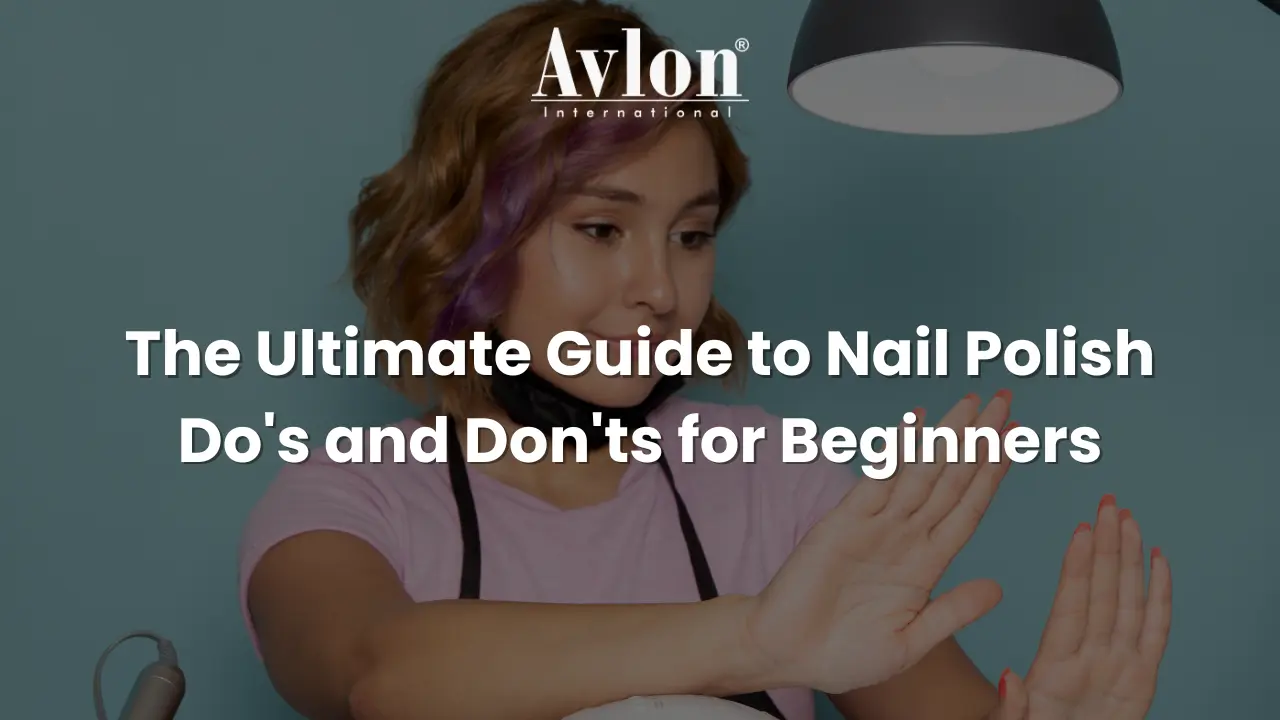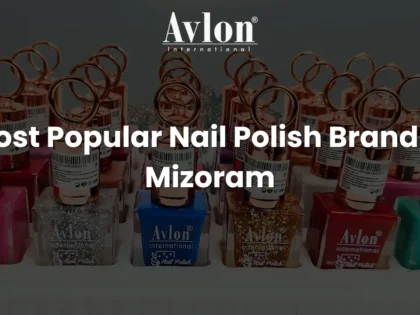The Ultimate Guide to Nail Polish Do’s and Don’ts for Beginners

For Distributors & Wholesalers
We welcome partnerships with distributors and wholesalers who wish to expand their business with a trusted and growing cosmetic brand.
Why Partner with Avlon International?
- Wide range of cosmetics: Nail polish, mascara, kajal, eyeliner, liquid lipstick, lipstick & more.
- Premium quality with competitive wholesale pricing.
- Attractive margins and fast-moving products.
- Assured support with marketing materials & promotional offers.
- PAN India shipping with secure packaging.
📦 Minimum Order Quantity (MOQ): 1 master carton (72 trays)
💰 Special Discounts: Available for bulk & long-term partners.
🚚 Dispatch & Delivery: PAN India in around 10-15 days.
📞 Contact Us:
Phone / WhatsApp: +91 88105 67775
Email: contactus@avloninternational.com
Website: www.avloninternational.com
Welcome to the wonderful, sometimes chaotic world of nail polish! If you’ve ever looked at someone’s perfectly manicured nails and wondered if they possess some sort of magical powers (spoiler alert: they don’t, they just know the rules), then you’ve landed in exactly the right place. Today, we’re diving deep into the essential nail polish dos and don’ts for beginners that will transform you from a nail novice into someone who can paint their nails without looking like they’ve been finger-painting during an earthquake.
Let’s face it – we’ve all been there. Standing in front of the mirror at 11 PM, attempting to apply nail polish with the precision of a surgeon, only to end up with more polish on our cuticles than on our actual nails. It’s like trying to eat spaghetti on a first date – theoretically possible, but fraught with potential disasters.
But here’s the good news: mastering nail polish application isn’t rocket science (though sometimes it feels more complicated than understanding your phone’s latest software update). With the right knowledge, quality products, and a hefty dose of patience, you’ll be creating salon-worthy manicures in the comfort of your own home faster than you can say “quick-dry topcoat.”
The Foundation: Essential Do’s for Nail Polish Beginners
DO Start with Clean, Properly Prepared Nails
Think of nail preparation as the foundation of a house – skip this step, and everything else will come crashing down faster than a house of cards in a windstorm. Clean nails are happy nails, and happy nails hold polish better than a good friend holds your secrets.
Begin by removing any existing polish completely. Don’t be tempted to paint over old polish because you’re in a hurry – that’s like putting makeup over yesterday’s makeup and expecting it to look fresh. Use a quality nail polish remover and cotton pads, working from the base of the nail to the tip to avoid spreading color around like abstract art.
Once your nails are polish-free, give them a gentle push-back of the cuticles. You don’t need to go full medieval on them with aggressive cutting – a gentle push with a cuticle pusher or even an orange stick will do the trick. Think of this as creating a clean canvas for your masterpiece.
Wash your hands thoroughly to remove any oils or residue. This step is crucial because oils are the arch-nemesis of nail polish adhesion. They’re like that friend who always cancels plans at the last minute – they prevent things from sticking around.
DO Invest in Quality Base and Top Coats
Here’s a truth that might surprise you: the actual colored polish is just the middle act in a three-part performance. The base coat and top coat are the opening act and the grand finale, and they’re equally important for a show-stopping manicure.
A good base coat is like a primer for your nails. It creates a smooth surface for the color to adhere to and prevents staining (because nobody wants nails that look like they’ve been tie-dyed). It also helps extend the life of your manicure, which means fewer touch-ups and more time for important things like binge-watching your favorite series.
Top coat is your manicure’s bodyguard. It protects the color from chips, adds shine, and speeds up drying time. Skipping top coat is like going out in the rain without an umbrella – you might survive, but you’re definitely going to regret it.
Avlon International has developed comprehensive nail care systems that include high-quality base and top coats designed to work harmoniously with their color polishes, ensuring professional results every time.
DO Use Thin, Even Coats
This is perhaps the most important rule in the nail polish bible, yet it’s the one most beginners struggle with. The temptation to glob on thick coats in an attempt to achieve full coverage in one swipe is stronger than the urge to eat chocolate at midnight, but resist it you must.
Thin coats dry faster, look more professional, and are less likely to bubble, streak, or chip. Think of it like layering clothing – multiple thin layers provide better coverage and flexibility than one thick, clunky layer.
Start with a stripe down the center of the nail, then fill in the sides with smooth, even strokes. Don’t worry if you can see your nail through the first coat – that’s completely normal and expected. Two to three thin coats will give you better results than one thick coat every single time.
The key is to work quickly but deliberately. Polish starts to set quickly, so don’t go back over areas you’ve already painted unless absolutely necessary. It’s like wet cement – the more you mess with it, the worse it looks.
DO Allow Proper Drying Time Between Coats
Patience, young grasshopper. In our instant-gratification world, waiting for nail polish to dry feels like watching paint dry (which, technically, it is). But rushing this step is like trying to frost a cake that’s still warm – messy and disappointing.
Each coat needs adequate time to set before applying the next one. This usually means waiting 2-3 minutes between thin coats. Use this time productively – answer texts, practice your acceptance speech for imaginary awards, or contemplate life’s mysteries.
You’ll know a coat is ready for the next layer when it’s no longer tacky to a very light touch. Don’t press hard or you’ll leave fingerprints that will make your manicure look like evidence from a crime scene.
Critical Don’ts That Can Ruin Your Manicure
DON’T Skip the Base Coat (Ever, Ever, Ever)
Let’s address the elephant in the room: we’ve all been tempted to skip base coat because we’re in a hurry or we think it’s just another marketing ploy by beauty companies to make us buy more products. But skipping base coat is like skipping sunscreen on a beach day – you might get away with it once, but eventually, you’ll pay the price.
Without base coat, polish can stain your nails, especially darker colors. Have you ever removed black or deep red polish only to find your nails looking like they’ve been stained with permanent marker? That’s what happens when you skip base coat.
Base coat also provides crucial adhesion. Polish applied directly to naked nails is more likely to chip and peel because it doesn’t have anything to properly grip onto. It’s like trying to stick a poster to a wall without tape – it might stay up for a while, but it’s not going to last.
DON’T Shake the Bottle Vigorously
This might be the most counterintuitive rule on our list because shaking seems like the logical way to mix things up. But nail polish bottles are not martinis, and vigorous shaking will introduce air bubbles into the formula faster than gossip spreads in a small town.
Those air bubbles don’t just disappear when you apply the polish – they show up as tiny bubbles on your nails that make your manicure look like it has a case of nail acne. Instead of shaking, roll the bottle between your palms for 10-15 seconds. This mixes the formula without creating unwanted bubbles.
If your polish has separated (which happens naturally over time), rolling might not be enough. In this case, you can shake gently – emphasis on gently – and then let the bottle sit for a few minutes to allow any bubbles to rise to the surface before using.
DON’T Apply Thick Coats Thinking It Will Save Time
This is the nail polish equivalent of thinking you can lose weight by crash dieting – it seems logical in theory but creates more problems than it solves. Thick coats might seem like a shortcut to full coverage, but they’re actually a express train to Manicure Disaster Station.
Thick coats take forever to dry, often remaining gummy underneath even when the surface feels dry. This leads to dents, smudges, and sheet marks (you know, those lovely imprints from your bedsheets because you thought your nails were dry enough for sleep).
Thick coats are also more prone to shrinking as they dry, which can cause the polish to pull away from the edges of your nails. This creates gaps that make your manicure look unprofessional and shortens its lifespan significantly.
Avlon International formulates their polishes to provide optimal coverage with thin coats, understanding that patience in application leads to superior results.
DON’T Use Old, Gloopy Polish
We all have that one bottle of polish that’s been sitting in our collection since before smartphones were invented. It’s thick, gloopy, and applies about as smoothly as peanut butter, but we keep it because it’s our favorite color and we’re emotionally attached.
Old, thick polish is impossible to apply evenly and will make your manicure look like you painted your nails while wearing oven mitts. If your polish has thickened beyond repair, it’s time to say goodbye. Think of it as Marie Kondo-ing your nail collection – if it doesn’t spark joy (or apply smoothly), thank it for its service and let it go.
You can extend the life of polish by storing it properly (in a cool, dark place) and using a few drops of nail polish thinner when it starts to thicken. But there comes a point where even the best polish thinner can’t save a formula that’s past its prime.
Advanced Tips for Nail Polish Success
Master the Cleanup Process
Even professional nail technicians get polish on skin sometimes – the difference is they know how to clean it up like it never happened. Cleanup is an art form that separates the amateurs from the pros, and mastering it will elevate your manicures from “homemade” to “salon-quality.”
The best time for cleanup is while the polish is still slightly wet. Use a small, flat brush (an old eyeliner brush works perfectly) dipped in nail polish remover to carefully remove excess polish from around the nail. Work slowly and precisely – you’re a surgeon of the nail world.
For more precise cleanup, try using a cuticle pusher wrapped in a small piece of cotton and dipped in remover. This gives you more control than a brush and allows you to get into tight spaces around the cuticle area.
Some people prefer to use liquid latex or special tape around their nails before applying polish, creating a barrier that makes cleanup easier. While this adds time to your routine, it can be worth it for complex nail art or when using particularly messy formulas.
Understanding Your Polish Formula
Not all nail polishes are created equal, and understanding the formula you’re working with can make the difference between a successful manicure and a frustrating mess. Some polishes are naturally more pigmented and provide full coverage in one coat, while others are designed to be built up gradually.
Cream polishes typically provide the most opacity and are forgiving for beginners. Sheer polishes require more coats but create beautiful, buildable color. Glitter polishes have their own set of rules and often require special removal techniques.
Avlon International creates detailed product information for each of their formulas, helping users understand the best application techniques for optimal results.
The Art of Color Selection
Choosing the right color isn’t just about personal preference – some colors are more forgiving for beginners than others. Light colors tend to show brush strokes and imperfections more than dark colors, while very dark colors can be unforgiving if your application isn’t perfect.
Medium-toned colors like classic reds, roses, and berry shades are often the most forgiving for beginners. They provide good coverage, hide minor imperfections, and complement most skin tones.
Metallic and glitter polishes can also be forgiving because their finish helps disguise minor application flaws. However, they often require special removal techniques, so factor that into your decision.
Troubleshooting Common Beginner Mistakes
Dealing with Bubbles
Bubbles in nail polish are like hiccups – annoying, seemingly random, and frustrating when they happen at the worst possible moment. The most common cause is shaking the bottle, but bubbles can also form if you apply polish too quickly or in very humid conditions.
If you notice bubbles forming as you apply polish, don’t try to brush them out – this will only make them worse. Instead, let that coat dry completely, then gently buff the surface smooth with a fine buffer before applying your next coat.
Prevention is better than cure when it comes to bubbles. Always roll your polish bottle instead of shaking, apply thin coats, and avoid applying polish in very humid conditions (like right after a hot shower).
Fixing Streaky Application
Streaky polish application is usually the result of either too-thick polish, inadequate mixing, or trying to go back over areas that have already started to set. The solution depends on the cause.
If your polish is too thick, thin it with a few drops of nail polish thinner (never use nail polish remover for this – it will ruin the formula). If the polish wasn’t mixed properly, roll the bottle more thoroughly before your next application.
The most common cause of streaking is trying to fix areas that have already started to dry. Once polish begins to set, leave it alone. If you’re not happy with the coverage, let it dry completely and add another thin coat.
Managing Drying Time
In our fast-paced world, waiting for nail polish to dry feels like an eternity. But there are legitimate ways to speed up the process without compromising the quality of your manicure.
Quick-dry top coats can significantly reduce drying time while adding shine and protection. Some people swear by dipping freshly painted nails in ice water, though this technique requires practice to avoid smudging.
Avlon International offers fast-drying formulas that maintain quality while reducing waiting time, perfect for busy lifestyles.
The most important thing to remember is that surface dry and completely dry are two different things. Even if your nails feel dry to the touch, the polish underneath might still be soft. Plan for at least 30 minutes of careful activity after your final coat.
Nail Health and Polish Application
Protecting Your Natural Nails
Beautiful nail polish means nothing if the nails underneath aren’t healthy. Always use base coat to prevent staining and provide a protective barrier between your natural nail and the polish.
Give your nails a break between manicures. While it’s tempting to always have polished nails, allowing them to breathe occasionally helps maintain their health and strength.
Keep your cuticles moisturized with cuticle oil or cream. Healthy cuticles not only look better but also provide a better foundation for polish application.
Knowing When to Start Over
Sometimes, despite our best efforts, a manicure just isn’t working out. Knowing when to cut your losses and start over is a valuable skill that will save you time and frustration in the long run.
If your base coat goes on streaky or bubbled, it’s better to remove it and start again rather than trying to build on a flawed foundation. The same applies if your first coat of color goes on poorly – no amount of additional coats will fix a fundamentally flawed application.
The Psychology of Perfect Nails
Building Confidence Through Practice
Like any skill, nail polish application improves with practice. Don’t expect perfection on your first try – even professional nail technicians spent years honing their craft. Each manicure is a learning opportunity.
Start with your non-dominant hand first. This might seem counterintuitive, but if you’re going to have one hand that’s less than perfect, better it be the one that’s easier to hide.
Keep realistic expectations. Your first few attempts might not look Instagram-worthy, and that’s perfectly normal. Focus on improvement rather than perfection.
Creating Your Own Nail Care Routine
Developing a consistent nail care routine makes the actual polish application much easier and more successful. This includes regular moisturizing, proper nail shaping, and consistent cuticle care.
Avlon International advocates for comprehensive nail care routines that go beyond just polish application, understanding that healthy nails are the foundation of beautiful manicures.
Advanced Techniques for the Future
Exploring Nail Art
Once you’ve mastered basic polish application, the world of nail art opens up endless possibilities. Start simple with techniques like dots, stripes, or gradient effects before moving on to more complex designs.
The key to successful nail art is patience and practice. Don’t attempt complicated designs until you’ve mastered the basics – it’s like trying to run before you can walk.
Understanding Different Finish Types
As you become more comfortable with nail polish, you’ll want to explore different finish types beyond basic cream polishes. Matte polishes, chrome effects, and texture polishes each have their own application techniques and care requirements.
Avlon International offers a comprehensive range of finishes and effects, allowing nail enthusiasts to experiment with different looks while maintaining quality and performance.
Conclusion: Your Journey to Nail Polish Mastery
Mastering nail polish application is a journey, not a destination. Every manicure teaches you something new, whether it’s a technique that works perfectly or a mistake that you’ll never make again. The key is to approach each application with patience, the right tools, and realistic expectations.
Remember that even the most experienced nail polish enthusiasts started as beginners. The difference between a novice and an expert isn’t natural talent – it’s knowledge, practice, and the willingness to learn from mistakes.
These nail polish do’s and don’ts for beginners provide the foundation for beautiful manicures, but don’t be afraid to experiment and develop your own techniques as you gain experience. With quality products from trusted manufacturers like Avlon International and consistent practice, you’ll soon be creating salon-worthy manicures that would make professional nail technicians proud.
The most important rule of all? Have fun with it. Nail polish is a form of self-expression, creativity, and self-care all rolled into one tiny bottle. Whether you prefer classic reds, bold blues, or subtle nudes, the perfect manicure is the one that makes you feel confident and beautiful.
So grab your favorite polish, take a deep breath, and remember – every expert was once a beginner. Your nail polish journey starts now, armed with knowledge, enthusiasm, and hopefully fewer disasters than my first attempt (which, for the record, looked like I had painted my nails during a particularly intense earthquake). Happy polishing!
📌 Disclaimer
The information provided in this blog is for general informational purposes only. While Avlon International makes every effort to ensure the accuracy and reliability of the information shared, we make no representations or warranties of any kind, express or implied, about the completeness, accuracy, reliability, suitability, or availability with respect to the content.
Any reliance you place on such information is therefore strictly at your own risk. Avlon International shall not be held liable for any loss, damage, or inconvenience arising in connection with the use of this blog or its content.
For official details regarding our products, distributor policies, or business partnerships, please contact us directly at WhatsApp +91 88105 67775.




